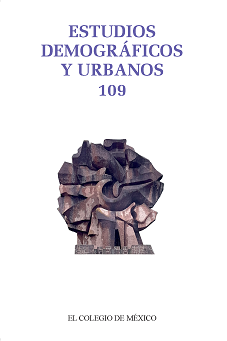Urban renovation in the edges of the city: An urban acupuncture exercise in Arequipa and Bogotá
Published 2022-03-03
Keywords
- urban borders,
- strategic planning,
- urban acupuncture,
- urban renewal in periphery areas,
- socio-spatial consistency
How to Cite
-
Abstract2712
-
PDF (español)1204
-
En línea (español)490
-
EPUB (español)21
-
Kindle (español)27
-
Audio (español)4
Downloads
Copyright (c) 2022 Estudios Demográficos y Urbanos

This work is licensed under a Creative Commons Attribution-NonCommercial-NoDerivatives 4.0 International License.
Metrics
Abstract
This paper integrates, in light of the concept of urban acupuncture, two case studies developed by researchers from Peru and Colombia, around the problem of the systemic integration of urban edges to the formal dynamics of the city, focusing on urban renewal committed to improving the periphery zones that have situations of high risk and unplanned growth, historically forgotten by the conventional methodologies of urban and territorial planning. These zones are marked by situations of fragmentation and physical and social precariousness and negatively affect the conditions of habitability, governability, productivity, and connectivity of the city. The Peruvian case offers a methodology that integrates the notions of urban catalysis, the social construction of habitat and participatory design. The Colombian case proposes a planning instrument that, from the definition of urban renewal criteria in depressed peripheral environments, allows the establishment, based on the so-called socio-spatial consistency, of a strategy for addressing areas of high environmental, physical and social risk, due to the development of networks of facilities and services related to housing and other compatible land use. As a result, a comparative analysis is proposed, contributing to a re-semantic approach to urban planning, incorporating the periphery and facing marginality.
References
- Attoe, W. y Logan, D. (1989). American urban architecture. Catalysis in the design of cities. Londres: University of California Press.
- Birkmann, J., Cardona, D., Carreño, M. L., Barbat, A. H., Pelling, M., Schneiderbauer, S., Kienberger, S., Keiler, M., Alexander, D., Zeil, P. y Welle, T. (2013). Framing vulnerability, risk and societal responses: The MOVE framework. Natural Hazards, 67(2), 193-211. https://link.springer.com/article/10.1007/s11069-013-0558-5 DOI: https://doi.org/10.1007/s11069-013-0558-5
- Borsdorf, A. (2003). Cómo modelar el desarrollo y la dinámica de la ciudad latinoamericana. Eure. Revista Latinoamericana de Estudios Urbano Regionales, 29(86), 37-49. https://scielo.conicyt.cl/scielo.php?script=sci_arttext&pid=S0250-71612003008600002 DOI: https://doi.org/10.4067/S0250-71612003008600002
- Capra, F. (2012). Las conexiones ocultas. Barcelona: Anagrama.
- Departamento Administrativo Nacional de Estadística (DANE). (2017). Estadísticas por tema: demografía y población. Bogotá.
- Echeverría, M. C., Mayo, R. A. y Múnera, M. C. (2013). Escuela territorial ciudadana para la construcción social del hábitat: propuesta. Medellín: Universidad Nacional de Colombia.
- Folke, C., Carpenter, S., Elmqvist, T., Gunderson, L., Holling, C. y Walker, B. (2002). Resilience and sustainable development: Building adaptive capacity in a world of transformations. Ambio, Journal of the Human Environment, 31(5), 437-440. https://www.ncbi.nlm.nih.gov/pubmed/12374053 DOI: https://doi.org/10.1579/0044-7447-31.5.437
- Geertz, C. (1994). Conocimiento local. Ensayo sobre la interpretación de las culturas. Barcelona: Paidós.
- Gehl, J. (2006). La humanización del espacio urbano. Barcelona: Reverté.
- Hidalgo, A. y Cubillo, A. P. (2016). Transmodernidad y transdesarrollo. El decrecimiento y el buen vivir como dos versiones análogas de un transdesarrollo transmoderno. Huelva: Bonanza.
- INEI (2018). Censos Nacionales: XII de Población, VII de Vivienda y III de Comunidades Indígenas. Instituto Nacional de Estadística e Informática. https://www.inei.gob.pe/media/MenuRecursivo/publicaciones_digitales/Est/Lib1541/index.htm
- IMPLA (2016). Plan de Desarrollo Metropolitano de Arequipa 2016-2025. Municipalidad Provincial de Arequipa, Perú.
- Lerner, J. (2003). Acupuntura urbana. Río de Janeiro: Record.
- Maturana, H. y Varela, F. (1994). El árbol del conocimiento: las bases biológicas del entendimiento humano. Santiago de Chile: Editorial Universitaria.
- Muller, M. (2007). Adapting to climate change: Water management for urban resilience. Environment and Urbanization, 19(1), 99-113. https://journals.sagepub.com/doi/abs/10.1177/0956247807076726 DOI: https://doi.org/10.1177/0956247807076726
- Múnera, M. C. (2007). Resignificar el desarrollo. Medellín: Universidad Nacional de Colombia.
- Pesci, R. (1999). La ciudad de la urbanidad. La Plata: CEPA.
- Rossi, A. (2019). Autobiografía científica. Barcelona: Gustavo Gili.
- UCL Space Syntax (2019). Axial map. En Glossary. http://otp.spacesyntax.net/term/axial-map/
- Vergara Gómez, A. y De las Rivas. J. L. (2004). Planes estratégicos de ciudades. Madrid: Fundación Metrópoli.
- Yory, C. M. (2009). Pensamiento urbano contemporáneo. Una aproximación desde el concepto de topofilia. Bogotá: Centro Editorial Javeriano.
- Yory, C. M. (2013). El desarrollo territorial integrado. Una estrategia sustentable de construcción social del territorio, en el contexto de la globalización, a partir del concepto de topofilia. Bogotá: Universidad Piloto de Colombia.
- Yory, C. M. (2015). La construcción social del hábitat: conceptos, indicadores y consideraciones de política pública. Bogotá: Universidad Piloto de Colombia.
- Yory, C. M. (2017). Lugar y territorio. Bogotá: Universidad Piloto de Colombia. DOI: https://doi.org/10.2307/j.ctv8j5sf
- Yory, C. M. (2020). Renovación urbana, globalización y patrimonio. Bogotá: Universidad Católica de Colombia.
- Zeballos, C. (2006). Evaluation of the characteristics of urban landscape development in Arequipa from 1868 to 1940. (Tesis de doctorado, Graduate School of Engeneering). Japón: Kyoto University. https://pdfs.semanticscholar.org/2fad/d652b53fe9f5f51d4dbc46828a7784a4788a.pdf
- Zeballos, C. (2016). Herramientas de planeamiento urbano para incrementar la resiliencia de las ciudades. El Plan de Desarrollo Metropolitano de Arequipa. Arkinka, 250, 38-47. https://www.researchgate.net/publication/315729615_HERRAMIENTAS_DE_PLANEAMIENTO_URBANO_PARA_INCREMENTAR_LA_RESILIENCIA_DE_LAS_CIUDADES
- Zeballos, C. (2018). Ciudad, de la periferia a las centralidades. Ponencia presentada en el Congreso Internacional de Gestión del Desarrollo y Ordenamiento Territorial, Arequipa, Perú.
- Zeballos, C. (2020). Atlas ambiental de Arequipa. Perú: Universidad Católica de Santa María.
- Zeballos, C., González, R., Urquizo, J. y Chacón-Cornejo, A. (2017). Urban linkages: A methodological framework for a network neighbour centralities in the periphery of Arequipa, Peru, as a social - environmental alternative to climate change in vulnerable settlements. Ponencia presentada en el UIA World Architects Congress, Seúl, Corea. http://www.uia2017seoul.org/P/papers/Full_paper/Paper/Oral/PS1-52/O-0330.pdf


